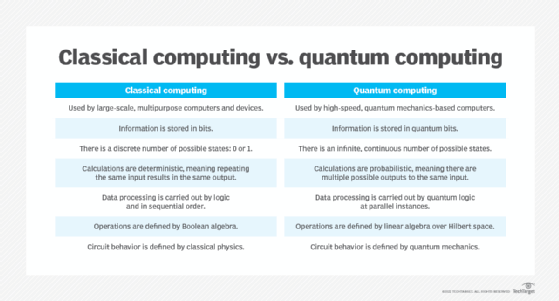qubit (short for quantum bit)
What is qubit (short for quantum bit)?
A qubit (short for quantum bit) is the basic unit of information in quantum computing and counterpart to the bit (binary digit) in classical computing. A qubit plays a similar role as a bit, in terms of storing information, but it behaves much differently because of the quantum properties on which it's based.
In a quantum computer, a number of elemental particles such as electrons or photons can be used (in practice, success has also been achieved with ions), with either their charge or polarization acting as a representation of 0 and/or 1. Each of these particles is known as a qubit; the nature and behavior of these particles (as expressed in quantum theory) form the basis of quantum computing. Two of the most relevant aspects of quantum physics are the principles of superposition and entanglement.

Qubit and superposition
When used as a qubit, a particle is placed in a controlled environment that protects it from outside influences. For example, it might be floated in a magnetic field or embedded specialized circuitry, which is then isolated from the outer environment. In many cases, the entire mechanism is encased in a refrigerated compartment to minimize subatomic disturbances, with temperatures often near absolute zero, or 0 kelvin.
Researchers are experimenting with a variety of approaches to creating an environment in which the qubits can be reliably manipulated and measured without being affected by outside factors. For example, one approach is to suspend an electron in an electromagnetic field and control the electron's spin state, while isolating the electron from external influences. When the electron's spin is aligned with the field, it is in a spin-up state. When it is opposite to the electromagnetic field, it is in a spin-down state.
The electron's spin can be changed from one state to another by directing a pulse of energy at the particle. The energy might come from a laser beam, microwaves or another source. Each time the pulse is delivered, the electron spin state changes. The switch in state provides a mechanism for assigning a 0 or 1 to each qubit, similar to a bit in classical computing. However, quantum computing makes it possible to do much more with a qubit.
Suppose that the energy pulse delivered to the electron is 1 unit of energy. What happens if the pulse is only one-half a unit of energy? According to quantum law, the particle enters a state of superposition, behaving as if it were in both the spin-up and spin-down states simultaneously. The electron exists in a fluid state of probability that is mathematically represented by fractions between 0 and 1. It remains in this state until it is observed and measured.
The superposition property enables a quantum computer to be in multiple states at once. The number of possible states grows exponentially as the number of qubits increases. The possible states are represented as 2n, where n is the number of qubits. The following table shows the number of possible states for five qubit amounts:
| Number of qubits | Number of possible states |
| 2 |
22 = 4 |
| 5 |
25 = 32 |
| 10 |
210 = 1,024 |
| 50 |
250 = 1.126 × 1015 (approximate) |
| 100 |
2100 = 1.268 x 1030 (approximate) |
A quantum computer can do much more with its qubits than a classical computer can with the same number of bits. For example, a 2-bit register in a classical computer can store only one of four binary configurations (00, 01, 10 or 11) at any given time. However, a 2-qubit register in a quantum computer can store all four numbers simultaneously, and as more qubits are added, the number of states continues to increase exponentially. To achieve this type of growth, however, quantum computers must also take advantage of another important quantum property: entanglement.
Quantum computing and entanglement
When particles are generated or interact in certain ways, they become entangled -- that is, they retain a connection with each other even if separated by long distances. As part of this connection, their behavior is correlated across these distances as long as they remain entangled. Quantum computing uses this correlation to achieve the type of exponential growth promised by the superposition state.
When two entangled particles are measured, they are always in opposite spin states because of the correlation between them. When the spin state of one particle changes -- whether from up to down or down to up -- the spin state of the other particle also changes, but in the opposite direction. As a result, knowing the spin state of one entangled particle makes it possible to know the other's spin state.
When an entangled particle is measured, it communicates with the correlated particle, which simultaneously assumes the opposite spin direction. Einstein called this phenomenon "spooky action at a distance," and today's physicists still do not know why it occurs. However, this behavior has been proved through numerous experiments. It is now generally accepted as a given and plays a key role in quantum computing.
Quantum entanglement enables qubits to interact with each other instantaneously. This interaction is not affected by distance or limited to the speed of light. Together with superposition, entanglement makes it possible to greatly enhance computing power and perform calculations in a fraction of the time compared with today's most powerful classical computer.
Quantum computing is still in its infancy. Potential future applications include artificial intelligence and machine learning, financial modeling, cybersecurity, route and traffic optimization, manufacturing, drug and chemical research, and new materials to be incorporated into products such as batteries and semiconductors.
